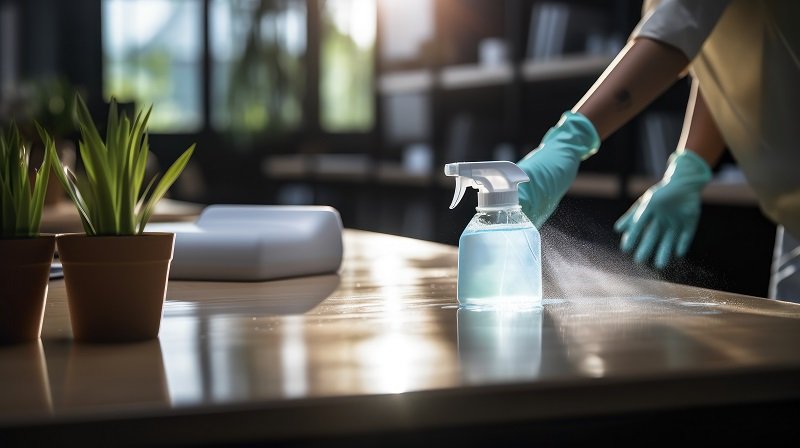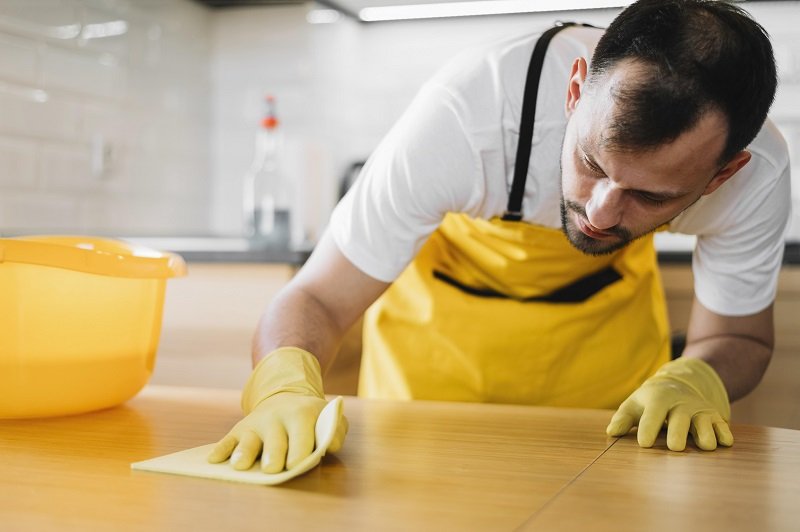Blog
How to Maintain and Clean Your Dining Table and Chairs?

Introduction
It’s a Sunday morning, and the light shines through your kitchen windows, putting a warm glow on the centerpiece of your dining room—a table that has seen numerous family dinners, holiday feasts, and late-night talks. Your dining table and chairs are more than simply pieces of furniture; they are silent witnesses to your family’s most treasured memories. Whether you’re meeting with loved ones for a holiday feast or simply enjoying a quiet cup of coffee, the dining table is where life occurs.
However, like any well-loved object in your house, your dining table set requires maintenance to maintain it in good condition. Maintaining and cleaning your dining table and chairs is more than simply keeping them looking good; it’s about honoring the memories they contain and ensuring they’re a beautiful, functioning component of your home for years to come. In this post, we’ll look at how to give your dining table set the attention it deserves, with practical advice specific to the material of your table and chairs.
Understanding Your Dining Furniture Material
Your dining table set can be built of a variety of materials, each adding unique charm and character to your house. However, these various materials require special care to retain their beauty and longevity. Similarly, understanding what your furniture is built of will help you preserve it in good shape.
1- Wooden Dining Table Set
Wooden dining table sets have stood the test of time and are frequently passed down through generations. They come with warmth and firmness, making them the centerpiece of any dining room. However, not all wood is made equal. Just as different varieties of wood generate different moods in a space, they also require varied care procedures.
- Hardwood: Hardwoods like oak, walnut, and maple are known for their strength and durability. They can withstand the test of time, but they also need regular care to stay in peak condition. Dusting weekly with a soft, dry cloth helps prevent scratches from accumulating, while periodic polishing keeps the wood looking vibrant and lustrous.
- Softwood: On the other hand, softwoods like pine bring a rustic charm to your home. They’re often lighter in color and more prone to scratches and dents. If your table is made of softwood, it needs a gentler touch—avoid harsh chemicals and use mild, non-abrasive cleaners. Softwoods may be less durable than hardwoods, but with the right care, they can still offer years of beauty and utility.
- Waxed Wood: If your wooden dining table set has a wax finish, think of it as a shield—a layer of protection that not only enhances the wood’s natural beauty but also helps repel water and stains. However, this shield needs regular upkeep. Reapplying wax every few months keeps the finish strong, allowing your table to age gracefully while maintaining its protective coat.
2- Marble Dining Table Set
Marble dining table sets are the height of elegance and provide a touch of luxury to any dining space. Consider the cold, smooth surface of a marble table, with natural veining that adds character and class to your home. However, marble, like other luxury things, requires specific maintenance to retain its exquisite appearance.
Marble is a porous stone, which means it will quickly collect spills and stains if not properly sealed and cared for. It is also prone to acidic chemicals, which can result in etching (dull patches or scratches on the surface).
- Sealing: The first step in caring for a marble table is ensuring it is properly sealed. A good sealant acts as a barrier, preventing liquids from penetrating the surface and causing stains. It’s advisable to reseal your marble dining table set once or twice a year, depending on use.
- Cleaning Techniques: When it comes to cleaning, less is more. Use a soft cloth and a pH-neutral cleaner specifically designed for stone surfaces. Avoid using vinegar or any acidic cleaners, as these can eat away at the marble and cause damage. For daily upkeep, a simple wipe-down with warm water and a microfiber cloth is usually sufficient.
- Protective Measures: Placemats and coasters aren’t just a recommendation for marble dining table sets—they’re a necessity. Acidic foods and drinks like wine, coffee, or citrus can cause irreversible etching if they come into direct contact with the marble. By taking these small precautions, you can keep your marble table looking flawless.
3- Melamine Dining Table Set
Let’s now turn our attention to melamine, a material that is becoming increasingly popular in modern dining table sets due to its durability and affordability. Imagine melamine as your dining room’s everyday hero: practical, sturdy, and always ready to meet the challenges of daily living. It’s ideal for families with small children or those who frequently entertain, as it can easily handle spills, scratches, and stains.
Melamine is simply a hard plastic glued to a core material, such as MDF or plywood. Its smooth surface allows for simple cleaning and maintenance. Melamine is durable, but it is not indestructible. The key to maintaining your melamine table in good condition is regular, careful washing.
- Regular Cleaning: A quick wipe down after every meal with a damp cloth and mild dish soap is usually enough to keep your melamine table looking fresh. Avoid abrasive cleaners, as they can dull the surface over time. For tougher stains, a solution of vinegar and water can do wonders, gently lifting away grime without damaging the finish.
- Placemats and Coasters: Though the melamine dining table set is heat-resistant, using placemats and coasters is a smart way to prevent any accidental damage from hot dishes or beverages. It’s a simple habit that can extend the life of your table, keeping it looking new for years.
4- Glass Dining Table Set
Glass dining table sets are the preferred choice for those who value a sleek, modern appearance. Consider a glass table that reflects the natural light streaming into your dining area, providing a sense of openness. Glass tables are adaptable and may match a wide range of home designs, from minimalist to industrial.
However, while glass is beautiful, it is prone to fingerprints, smudges, and scratches, so it requires a little more care to keep its flawless appearance.
- Regular Cleaning: To keep your glass dining table set sparkling, regular cleaning is essential. A mixture of water and vinegar or a dedicated glass cleaner works best. Spray the solution onto a microfiber cloth (not directly onto the glass) to avoid streaks, and gently wipe the surface. For stubborn marks, use a soft, non-abrasive sponge.
- Preventing Scratches: While the glass dining table set is relatively durable, it can scratch easily if not handled with care. Avoid placing sharp or heavy objects directly on the table, and use placemats or felt pads under tableware to protect the surface. If your table does suffer minor scratches, a bit of clear nail polish or a glass repair kit can help minimize their appearance.
5- Metal Dining Table Set
Metal dining table sets are the hidden heroes of durability and contemporary style. Whether you have an all-metal table or one with metal legs and accents, this material provides a sleek, industrial design that is both elegant and durable. Consider metal to be the backbone of your dining room—strong, dependable, and capable of supporting a wide range of architectural components.
However, metal furniture is prone to rust, particularly in humid conditions, and requires extra maintenance to avoid oxidation and keep its gloss.
- Regular Dusting: Regular dusting with a soft, dry cloth helps to prevent dirt and grime from building up on the metal surfaces. If your table has intricate metalwork, use a soft brush to get into the nooks and crannies.
- Cleaning Techniques: For more thorough cleaning, a mixture of mild soap and warm water works wonders. Be sure to dry the metal completely afterward to prevent water spots or rusting. For stubborn spots or tarnishes, a metal cleaner or polish specific to the type of metal (such as stainless steel or iron) can help restore its shine.
- Rust Prevention: To prevent rust, especially on tables kept in humid environments, consider applying a protective wax or oil. This adds a barrier against moisture, ensuring your metal table stays rust-free and looks its best.
6- Quartz Dining Table Set
Quartz, a combination of natural stone and resin, is known for its durability and low care requirements, making it an increasingly popular choice for modern dining tables. Consider a quartz table to be your dining room’s workhorse—beautifully constructed yet strong and resilient enough to endure the everyday demands of family life.
Quartz tables mix the aesthetics of natural stone with the functionality of manufactured materials. Quartz, unlike marble, is non-porous, which means it does not absorb liquids and is very resistant to stains. However, some maintenance is necessary to keep it in good condition.
- Regular Cleaning: Quartz surfaces are best maintained with a simple routine. A soft cloth or sponge with warm water and mild dish soap will usually do the trick. Avoid harsh chemicals or abrasive cleaners, as these can damage the resin and dull the finish over time.
- Preventing Damage: While quartz is heat-resistant, it’s still wise to use trivets or hot pads under hot dishes to prevent potential damage. Additionally, although quartz is scratch-resistant, it’s not completely scratch-proof. Using placemats or cutting boards will help keep the surface scratch-free.

Dining Table Set Cleaning Techniques
Now that we’ve covered the specifics of different materials, let’s look at basic cleaning strategies that can help you keep your dining table set looking great, regardless of what they’re made of. Maintaining a clean and well-cared-for dining table set is more than just a task; it’s a continuous routine that will keep your furniture looking and functioning well for years to come.
- Regular cleaning is the foundation of good furniture upkeep. This does not imply spending hours every day, but rather establishing tiny, regular behaviors such as wiping clean surfaces after meals. A moist microfiber cloth is generally enough to remove crumbs and dust, leaving your table clean and ready for the next usage.
- Dusting isn’t just for the shelves and knick-knacks; your dining table and chairs need it too. Dust can settle on any surface, dulling the finish and potentially leading to scratches if left unchecked. A soft, dry cloth or a feather duster is ideal for this task. For more thorough dusting, especially for intricate designs or carvings on wooden chairs, a brush with soft bristles can help reach the nooks and crannies.
- Placemats and coasters are essential additions to every dining table set. They protect the surface of your table from hot meals, spills, and moisture, all of which can cause harm. Investing in high-quality placemats and coasters may dramatically increase the life of your dining table while also adding a beautiful touch to your dining space.
- A vinegar and olive oil combo works well as a natural cleanser and polisher for hardwood tables. The vinegar cleans the wood, while the olive oil restores its gloss and luster. Mix one part vinegar and two parts olive oil, apply with a soft cloth, and buff the wood to a nice shine. This procedure is especially useful for eliminating water rings and tiny scratches from timber surfaces.
- Applying Conditioners and Polish: Depending on the material of your dining table set, conditioners or polish can help keep it looking good and last longer. Wooden tables benefit from frequent cleaning using a substance that supports the wood while protecting it from drying out or breaking. Similarly, marble tables may require a particular polish to keep them shiny and stain-free. Always follow the manufacturer’s instructions for your type of table.
- Monitor Humidity: Wood, in particular, is sensitive to changes in humidity. Too much moisture in the air can cause wood to swell, while too little can cause it to crack. To prevent this, try to maintain a consistent level of humidity in your dining room. Using a humidifier in the winter or a dehumidifier in the summer can help protect your wooden furniture from the effects of extreme weather conditions.
- Takeaway: Regular, gentle care is key to preserving the beauty and functionality of your dining furniture. By establishing a routine and using the right products and techniques, you can enjoy a dining table and chairs that look great and last for years.

Precautions and Tips
Finally, let us discuss some basic precautions and advice for keeping your dining table set in the best possible shape. These are not simply practical tips, but habits that may help you safeguard your investment while also keeping your dining room looking welcoming and well-maintained.
- Avoid Direct Sunlight: Prolonged exposure to direct sunlight can cause fading and discoloration in many materials, including wood, fabric, and even some finishes on metal or glass. Consider the placement of your dining table and, if necessary, use curtains or blinds to protect it from harsh sunlight during the day.
- Use Furniture Pads: If your dining table and chairs are on a hard floor, such as wood or tile, furniture pads are essential. These small additions can prevent scratches and scuffs on both the floor and the furniture itself, preserving the integrity of both.
- Handle with Care: Be mindful when moving or rearranging your dining table and chairs. Lifting the furniture rather than dragging it will prevent unnecessary wear on the legs and joints, as well as avoid damaging your floors.
- Regular Inspections: Periodically inspect your dining table and chairs for any signs of wear, loose screws, or other issues. Addressing small problems early can prevent them from becoming larger, more costly repairs down the road.
Conclusion
Maintaining and cleaning your dining table and chairs is about more than simply preserving furniture; you’re also caring for the heart of your home. The dining room is where tales are told, meals are eaten, and memories are made, so it’s only natural that we give these items the care they deserve. Understanding the specific requirements of each material, from the long-lasting robustness of oak to the sleek beauty of glass, ensures that your dining set stays a beautiful and useful centerpiece for years to come.
Remember, each dining table set tells a unique tale via the meals it serves and the conversations it observes. Following these rules will ensure that the tale is a long and joyful one, with each meal and gathering adding another chapter to your home’s history.
FAQs
1- How often should I clean my dining table and chairs?
It depends on the material and frequency of use. For most dining tables, a weekly dusting and monthly deep clean should suffice. However, if you use your table daily, you might want to wipe it down after every meal to keep it looking fresh.
2- What’s the best way to remove water stains from a wooden table?
For water stains on wood, you can gently rub the area with a mixture of baking soda and water or use a non-gel toothpaste. Apply the mixture with a soft cloth, rubbing in the direction of the wood grain, then wipe clean and dry.
3- Can I use vinegar on all types of dining tables?
Vinegar is a great natural cleaner, but it should be used cautiously. It’s safe for most wood finishes if diluted with water, but avoid using it on marble or quartz as it can etch and dull the surface.
4- How do I prevent my glass dining table from scratching?
To prevent scratches on a glass table, use placemats, coasters, and tablecloths. Avoid dragging items across the surface, and clean with a soft microfiber cloth rather than abrasive materials.
5- What should I do if my marble table starts to look dull?
If your marble table starts to look dull, you can use a special marble polish to restore its shine. Regularly applying a stone sealant will also help protect the surface from staining and dulling over time.
6- Is it safe to use commercial cleaners on my dining table?
It depends on the cleaner and the material of your table. Always check the label to ensure the cleaner is safe for your table’s material. For wood, stick to gentle, non-abrasive cleaners, and for stone surfaces like marble or quartz, use a pH-neutral cleaner.
7- How can I protect my dining table from heat damage?
To protect your table from heat damage, always use trivets or heat-resistant mats under hot dishes. Never place hot pots or pans directly on the table, especially if it’s made of wood, glass, or stone.
8- What’s the best way to maintain the finish on a metal dining table?
For metal tables, dust them regularly and clean them with a damp cloth. To maintain the finish, avoid using harsh chemicals or abrasive pads. You can also apply a metal polish to keep it looking shiny and new.
9- Can I use a steam cleaner on my dining chairs?
Steam cleaners can be used on some fabric dining chairs, but it’s important to check the manufacturer’s instructions first. Steam cleaning can be too harsh for certain fabrics or finishes, so test a small area first to ensure it’s safe.
10- What should I do if my table wobbles or becomes uneven?
If your table wobbles, check the legs to see if they are loose and tighten any screws or bolts. If the floor is uneven, use felt pads or furniture levelers under the legs to stabilize the table.





